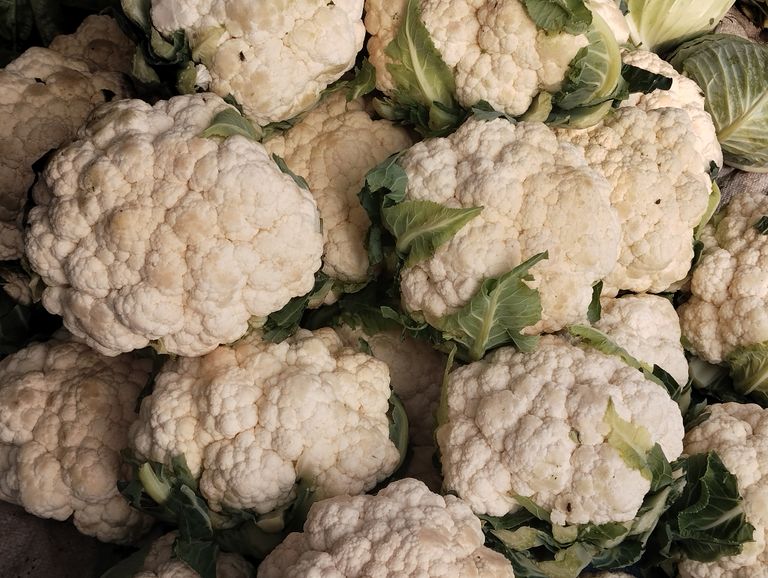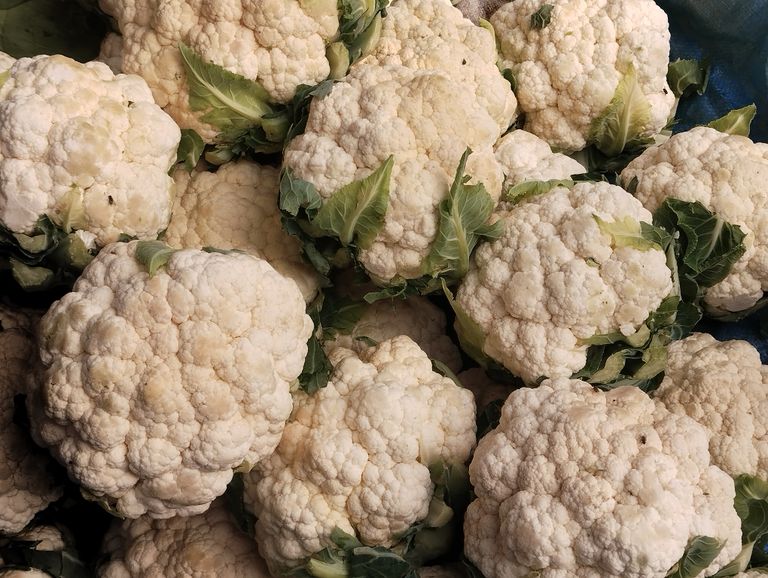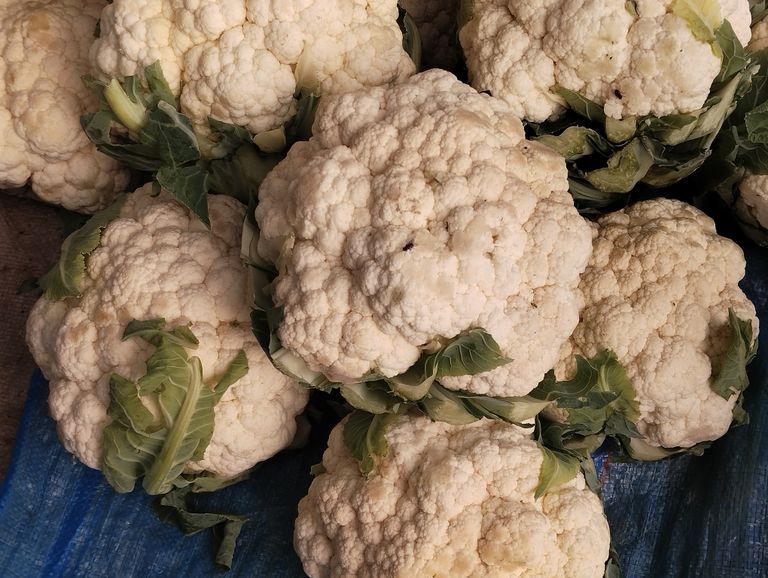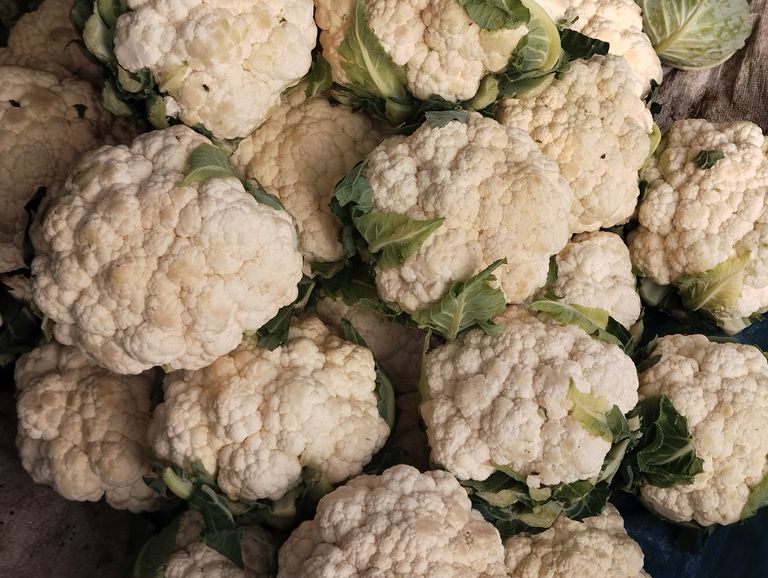
Cultivation of Cauliflower A Complete Guide.
Cauliflower, one of the most popular vegetables in the world, is widely grown for its versatility and nutritional value. Known for its creamy white curd, cauliflower thrives in cool climates and is a staple in many cuisines. This blog provides a step-by-step guide to cultivating cauliflower effectively.
- Introduction to Cauliflower
Cauliflower (Brassica oleracea var. botrytis) belongs to the Brassicaceae family and is a close relative of broccoli, cabbage, and kale. It is rich in vitamins C, K, and B6, as well as antioxidants and dietary fiber. Due to its adaptability, cauliflower can be grown in various regions with suitable climatic conditions.
- Climatic Requirements
Cauliflower thrives in cool, moist climates and is best suited for temperatures between 15°C and 20°C. Extreme heat or frost can damage the curd, so it's essential to choose the growing season carefully.
Optimal Growing Conditions:
Temperature: 15°C–20°C
Humidity: Moderate
Sunlight: Full sun, but avoid excessive heat
- Soil Preparation
Cauliflower grows best in well-drained, fertile soil with high organic matter content. The soil should have a pH of 6.0 to 7.5 for optimal growth.
Steps for Soil Preparation:
- Plow the field thoroughly to achieve a fine tilth.
- Add well-decomposed compost or farmyard manure (15–20 tons per hectare).
- Incorporate fertilizers like urea or superphosphate as per soil test recommendations.
- Ensure proper drainage to prevent waterlogging.
- Seed Selection and Sowing
Selecting high-quality seeds is crucial for a good yield. Choose seeds that are disease-resistant and suitable for your region's climate.
Steps for Sowing:
Nursery Preparation: Sow seeds in a well-prepared nursery bed.
Seed Rate: Use 400–600 grams of seeds per hectare.
Spacing: Maintain a spacing of 45–60 cm between rows and 40–50 cm between plants.
Depth: Sow seeds at a depth of 1–1.5 cm.
Transplant seedlings to the main field when they are 4–6 weeks old, ensuring 4–5 true leaves are present.
- Fertilizer Management
A balanced fertilizer application is essential for healthy growth. Fertilizer requirements depend on soil conditions.
Recommended Fertilizer Dosage:
Nitrogen (N): 120–150 kg/ha
Phosphorus (P): 60–80 kg/ha
Potassium (K): 60–80 kg/ha
Application Stages:
- Basal Application: Apply 50% of nitrogen and the full dose of phosphorus and potassium before transplanting.
- Top Dressing: Apply the remaining nitrogen in two split doses during the vegetative stage.
- Irrigation Practices
Cauliflower requires consistent moisture levels for uniform curd development. Overwatering or waterlogging should be avoided.
Irrigation Schedule:
Water the plants immediately after transplanting.
Irrigate every 7–10 days, depending on soil moisture levels and weather conditions.
Reduce watering during the curd formation stage to prevent splitting.
- Weed and Pest Management
Weeds and pests can severely impact cauliflower yield. Regular monitoring and timely control measures are crucial.
Weed Control:
Perform manual weeding or hoeing every 2–3 weeks.
Use mulching to suppress weed growth and retain soil moisture.
Common Pests:
- Aphids: Control using neem oil or insecticides like imidacloprid.
- Diamondback Moth: Use biological control agents or recommended pesticides.
- Cabbage Looper: Handpick larvae or use Bacillus thuringiensis (Bt) sprays.
Diseases:
Black Rot: Use disease-free seeds and avoid waterlogging.
Clubroot: Maintain proper soil pH and rotate crops.
- Harvesting and Post-Harvest Management
Cauliflower is ready for harvest when the curds are fully developed, compact, and white. Delayed harvesting can result in yellowing or over-maturity.
Steps for Harvesting:
- Cut the curd along with 2–3 surrounding leaves for protection.
- Harvest in the early morning or late afternoon to prevent wilting.
Post-Harvest Tips:
Store at 0°C with 95% humidity for extended shelf life.
Pack in perforated crates to reduce physical damage during transportation.
- Yield
The average yield of cauliflower varies depending on the variety and cultivation practices. Under ideal conditions, yields can range from 20–30 tons per hectare.
- Economic Benefits
Cauliflower cultivation is highly profitable due to its high market demand and adaptability. With proper planning and care, farmers can achieve significant returns on investment.
Cauliflower cultivation requires attention to detail, from selecting the right seeds to managing pests and diseases. By following these guidelines, you can ensure a healthy and profitable harvest. Whether you’re a seasoned farmer or a beginner, investing time and effort into cauliflower farming will undoubtedly yield rewarding results.

Delicious Bengali-Style Cauliflower Fry (Phulkopi Bhaji) Recipe
Phulkopi Bhaji, or cauliflower fry, is a classic Bengali dish loved for its simplicity, aroma, and flavor. This dry curry is made with cauliflower florets and a mix of aromatic spices. It's perfect as a side dish with steamed rice, dal, or even parathas. Let's dive into the recipe!
Ingredients:
1 medium-sized cauliflower (cut into small florets)
1 medium potato (optional, diced)
2 tbsp mustard oil (or any cooking oil)
1 tsp panch phoron (Bengali five-spice mix)
1-2 dried red chilies
1 medium onion (finely chopped)
1 medium tomato (finely chopped)
1 tsp turmeric powder
1 tsp red chili powder (adjust to taste)
½ tsp cumin powder
½ tsp coriander powder
Salt to taste
¼ cup green peas (optional)
1 tsp sugar (optional, for balance)
Fresh coriander leaves (for garnish)
Instructions:
Step 1: Prepare the Cauliflower
- Wash the cauliflower florets thoroughly in salted water. This helps to remove any insects or dirt.
- Blanch the florets in boiling water for 2-3 minutes, then drain and set aside.
Step 2: Cook the Vegetables
- Heat mustard oil in a pan until it reaches its smoking point. This step is crucial to eliminate the raw smell of the oil.
- Reduce the heat and add the panch phoron and dried red chilies. Let them splutter and release their aroma.
- Add the chopped onions and sauté until golden brown.
Step 3: Add Spices and Cook the Vegetables
- Stir in the chopped tomatoes and cook until they soften.
- Add turmeric powder, red chili powder, cumin powder, coriander powder, and salt. Mix well and cook for 1-2 minutes until the spices blend.
- Add the potatoes (if using) and cauliflower florets. Stir well to coat them with the spices.
Step 4: Simmer and Cook
- Add a splash of water to prevent the spices from burning. Cover the pan and cook on medium heat for 10-12 minutes, stirring occasionally.
- Add the green peas and sugar (if using) halfway through cooking.
Step 5: Final Touch
- Once the cauliflower and potatoes are tender and the spices are well combined, turn off the heat.
- Garnish with fresh coriander leaves for a burst of flavor and color.
Serving Suggestions:
Serve your Phulkopi Bhaji warm with steamed rice, dal, and a wedge of lime for a traditional Bengali meal. It can also be enjoyed with roti or paratha for a satisfying dinner.
Tips:
For an extra crunch, you can lightly fry the cauliflower florets before adding them to the pan.
Adjust the spice levels according to your preference.
Add a pinch of garam masala at the end for an enhanced flavor.
This humble yet flavorful Phulkopi Bhaji is a versatile dish that brings comfort and joy to any table. Try this recipe today and savor the taste of authentic Bengali cuisine.

Everything You Need to Know About Cauliflower: A Nutritional Powerhouse
Cauliflower, also known as Brassica oleracea, is a highly versatile and nutritious vegetable that has gained immense popularity in kitchens worldwide. Belonging to the cruciferous family, which includes broccoli, kale, and cabbage, cauliflower is loved not just for its subtle flavor but also for its remarkable health benefits.
In this blog, we’ll explore cauliflower’s history, nutritional profile, health benefits, culinary uses, and some fun facts about this humble vegetable.
The Origins and History of Cauliflower
Cauliflower has a fascinating history. It is believed to have originated in the Mediterranean region around 600 BC and was cultivated in ancient Rome. Over time, its cultivation spread to Europe, Asia, and eventually the rest of the world. By the 16th century, cauliflower became a prominent vegetable in French and Italian cuisine.
Today, cauliflower is grown globally, with countries like China, India, and the United States being the largest producers. Its adaptability to various climates and soil types has made it a staple crop in many regions.
Nutritional Profile of Cauliflower
Cauliflower is a nutrient-dense vegetable, offering a wide range of vitamins, minerals, and antioxidants while being low in calories. Here’s a breakdown of its nutritional composition per 100 grams of raw cauliflower:
Calories: 25 kcal
Protein: 1.9 grams
Carbohydrates: 5 grams
Fiber: 2 grams
Vitamin C: 80% of the recommended daily intake (RDI)
Vitamin K: 20% of the RDI
Folate: 14% of the RDI
Potassium: 9% of the RDI
Cauliflower is also rich in phytonutrients like glucosinolates and isothiocyanates, which are known for their anti-cancer properties.
Health Benefits of Cauliflower
- Rich in Antioxidants
Cauliflower is loaded with antioxidants, including vitamin C, beta-carotene, and quercetin. These compounds help neutralize free radicals, reducing the risk of chronic diseases like heart disease and cancer.
- Supports Digestive Health
Being high in fiber, cauliflower promotes healthy digestion and prevents constipation. The fiber also supports a healthy gut microbiome by acting as a prebiotic, nourishing beneficial gut bacteria.
- Boosts Immunity
The high vitamin C content in cauliflower strengthens the immune system, helping the body fight off infections and diseases.
- Aids in Weight Management
Low in calories and high in fiber, cauliflower is an excellent choice for those looking to lose or maintain weight. It provides a feeling of fullness, reducing overall calorie intake.
- Regulates Blood Sugar Levels
Cauliflower is a low-glycemic vegetable that helps regulate blood sugar levels. Its fiber content also slows down the absorption of sugar, making it a suitable option for individuals with diabetes.
- Promotes Heart Health
The antioxidants and anti-inflammatory properties in cauliflower contribute to heart health by reducing oxidative stress and improving cholesterol levels.
- Detoxifies the Body
The glucosinolates in cauliflower support the liver’s natural detoxification processes, aiding in the elimination of toxins.
Culinary Uses of Cauliflower
One of the best things about cauliflower is its versatility. It can be prepared in countless ways, making it a favorite among chefs and home cooks alike. Here are some popular culinary uses:
Cauliflower Rice: A low-carb alternative to traditional rice, made by grating or blending raw cauliflower into small granules.
Roasted Cauliflower: Tossed with olive oil and spices, roasted cauliflower develops a caramelized, nutty flavor.
Cauliflower Mash: A creamy and healthy substitute for mashed potatoes.
Cauliflower Pizza Crust: Ideal for gluten-free or low-carb diets, this crust is made from cauliflower, cheese, and eggs.
Soups and Stews: Cauliflower adds creaminess and texture to soups when blended.
Pickled Cauliflower: A tangy and crunchy addition to salads or sandwiches.
For adventurous cooks, cauliflower can even be turned into vegan buffalo wings, casseroles, or savory pancakes.
Fun Facts About Cauliflower
Cauliflower comes in various colors, including white, purple, orange, and green. Each color indicates a unique nutrient profile. For example, purple cauliflower contains anthocyanins, which have antioxidant properties.
The word “cauliflower” comes from the Latin caulis (meaning cabbage) and floris (meaning flower).
It’s a cool-season crop, thriving in temperatures between 15–20°C (59–68°F).
Romanesco, a type of cauliflower, is famous for its fractal-like appearance, which follows the Fibonacci sequence.
Cauliflower is often called a “superfood” due to its exceptional nutrient density and health benefits.
Growing Your Own Cauliflower
Cauliflower is relatively easy to grow in a home garden, provided you have the right conditions. It requires fertile soil, consistent watering, and cool temperatures. The plant matures in about 50–80 days, depending on the variety. Harvesting at the right time ensures a tender and flavorful vegetable.
Cauliflower is more than just a vegetable; it’s a powerhouse of nutrition, flavor, and versatility. Whether you’re looking to improve your health, try innovative recipes, or add variety to your meals, cauliflower is an excellent choice. Its global popularity is well-deserved, and with its many health benefits, it’s no wonder cauliflower continues to be a favorite in kitchens around the world.

Cauliflower Stir-Fry Recipe
Cauliflower stir-fry, or "phulkopi bhaji," is a simple yet flavorful dish that is a staple in many South Asian households. With minimal ingredients and a straightforward cooking process, it’s an ideal option for quick meals or as a side dish. This blog will take you through the step-by-step process of preparing delicious cauliflower stir-fry, along with tips and tricks to make it perfect every time.
Why Choose Cauliflower Stir-Fry?
Cauliflower is a versatile vegetable that absorbs spices beautifully, making it a favorite ingredient in vegetarian recipes. Not only is it healthy and packed with nutrients, but it's also budget-friendly and easy to find throughout the year.
Cauliflower stir-fry is an excellent choice for:
- Quick Meals: It takes less than 30 minutes to prepare.
- Healthy Eating: Cauliflower is low in carbs and calories but high in fiber and antioxidants.
- Side Dish or Main Course: Pair it with rice, flatbreads, or enjoy it as a standalone dish.
Ingredients
To make a delicious cauliflower stir-fry for 4 servings, you will need:
Vegetables:
1 medium-sized cauliflower (cut into small florets)
1 medium potato (optional, peeled and diced)
1 medium onion (sliced)
1 medium tomato (chopped)
Spices:
2-3 tablespoons of oil (vegetable/mustard oil for authentic flavor)
1 teaspoon mustard seeds or cumin seeds
1-2 green chilies (slit)
1 teaspoon turmeric powder
1 teaspoon red chili powder (optional)
1 teaspoon coriander powder
Salt to taste
A pinch of sugar (optional, for balance)
Garnish:
Fresh coriander leaves (chopped)
Lemon wedges (optional)
Cooking Instructions
Step 1: Preparing the Cauliflower
- Cut the cauliflower into bite-sized florets and soak them in salted water for 10-15 minutes. This helps to clean the florets and remove any hidden dirt or insects.
- Rinse thoroughly and drain the excess water.
Step 2: Cooking the Vegetables
- Heat oil in a pan or wok over medium heat.
- Add mustard seeds or cumin seeds and let them splutter.
- Add sliced onions and green chilies. Sauté until the onions turn golden brown.
- Add diced potatoes (if using) and stir-fry for 2-3 minutes.
Step 3: Adding Spices
- Add turmeric powder, red chili powder, coriander powder, and a pinch of salt. Mix well.
- Add cauliflower florets and stir to coat them evenly with the spices.
Step 4: Cooking the Cauliflower
- Cover the pan and cook on low-medium heat for 10-15 minutes. Stir occasionally to prevent burning.
- Once the cauliflower is tender, add chopped tomatoes and cook for another 3-4 minutes.
Step 5: Final Touches
- Check for seasoning and adjust salt or spices as needed.
- Garnish with freshly chopped coriander leaves.
Tips for the Perfect Cauliflower Stir-Fry
- Do Not Overcook: Cauliflower should be tender yet retain a slight crunch. Overcooking can make it mushy.
- Use Fresh Spices: Fresh and good-quality spices enhance the flavor of the dish.
- Customize the Vegetables: You can add other vegetables like carrots, peas, or bell peppers for variation.
- Experiment with Flavors: For a South Indian twist, add curry leaves and grated coconut.
Serving Suggestions
- Serve cauliflower stir-fry hot with steamed rice, chapati, or paratha.
- Pair it with dal (lentil soup) and papad for a wholesome meal.
- It can also be used as a filling for wraps or sandwiches.
Health Benefits of Cauliflower
- Rich in Nutrients: Cauliflower is an excellent source of vitamins C, K, and B6, as well as fiber and potassium.
- Low in Calories: It's perfect for weight-watchers due to its low calorie and high water content.
- Supports Digestion: The high fiber content promotes gut health and aids